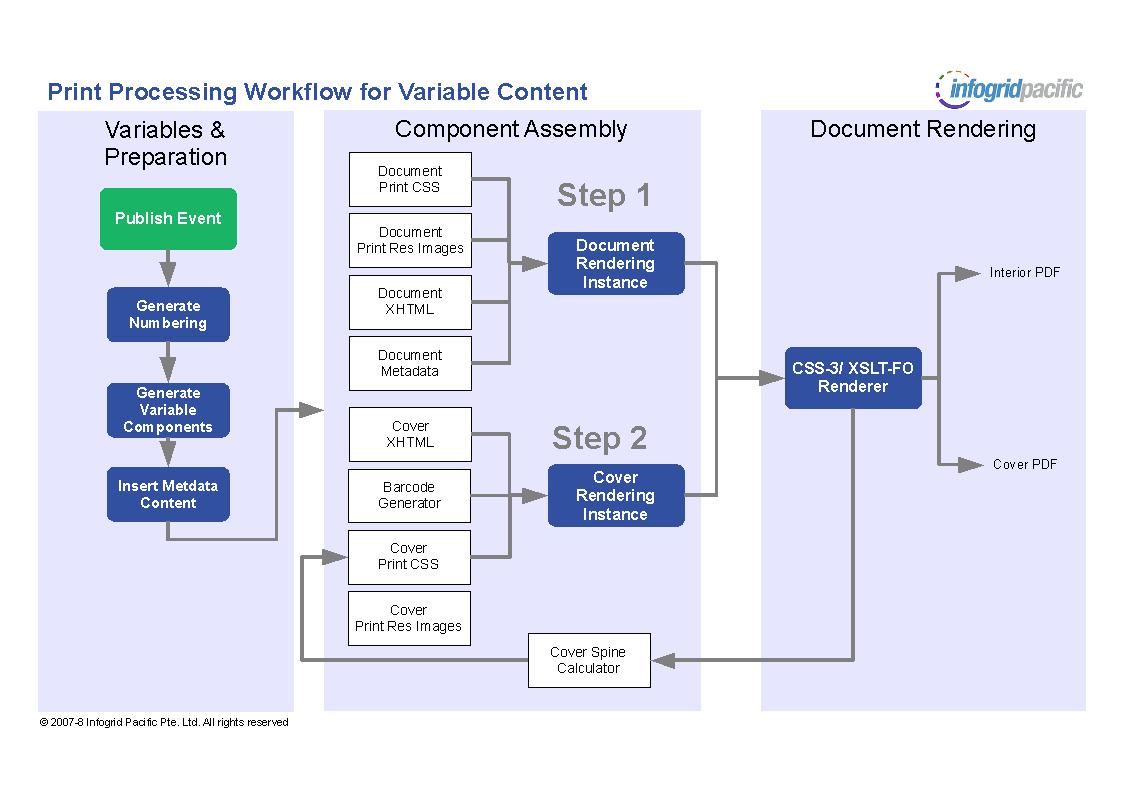9
Processing IGP:FoundationXHTML
Unlike most proprietary systems FX has been designed to lower costs (including into the future) associated with XML content production and processing. There is a clearly stated and defined set of rules which reduce the effort required to produce processors and variant products, but do not constrain future modifications, changes or migration to any other system, or even translation to another XML Schema.
Because it is designed for processing, and Infogrid Pacific has processors in place, immediate adoption of IPG:FoundationXHTML as a content encoding method is an easy decision.
Most importantly the processors are highly configurable (and extensible) to address the specific requirements of all content owners of any type of content with minimum configuration requirements. All processors are rules based tools working in three steps; content format conformance, format structure conformance, and finally the format packaging requirement.
While the Infogrid Pacific toolset support the features of IPG:FoundationXHTML explicitly, and some features are oriented towards these toolsets, FX has been designed to be non-proprietary in nature, technology neutral, and useful for any other XML tool or processing environments. it's archival and future reuse value is very high, and it has no survival dependencies on Infogrid Pacific tools or even Infogrid Pacific!
The standard IGP processors contain significant detail options that can be applied on a per document instance, or across a document collection.
Multi-template environments
IPG:FoundationXHTML has been designed to support sophisticated document template environments. It is a multi-layered set of templates, each of which can be maintained, used, customized and combined effortlessly. This flexibility is embedded into the core FX structures bringing unprecedented flexibility.
Presentation templates - are combinations of any other pre-created template components with genre specific styling. Examples are the supplied Default, Classic Book, Textbook Default, IGP Manuals, and Specification templates.
Document templates - these establish the default section construction of a document. Sections can contain any other content except other sections.
Content Block templates - there is a large range of content blocks defining nearly every conceivable internal document structure for every type of document genre. Custom Content Blocks can be quickly created and imported into any specific project.
All of this is possible because of the stability and standardization of the structural CSS selector descriptors in FX.
Multi-CSS environments
For XML to be used effectively for multi-format production, the tools and systems must be looked at from a fresh perspective. Infogrid Pacific identifies the following environments that need to be supported simultaneously by any contemporary XML system.
- XML Composition CSS
- Print CSS
- Reader CSS (Online / e-book formats)
- CSS indifferent Content Objects
In addition to the Multi-CSS enviroment, the standard CSS strategy is highly organized to make the creation of new templates easy and affordable without significant investment in technology. The structure of the CSS is such that frequently changed items such as custom titles and headers, can be very easily changed from the interface. While CSS is not specifically part of FX (CSS is a companion component), the XHTML is created to allow exploitation of all major CSS standards features for all applications. Ultimately the two are inseparable. It is the stability of the XHTML which allows the creativity and variations with the CSS in multiple ways - including not using it at all.
The presentation templates are constructed in such a way that automated updation of the CSS is possible for just certain styles of a document such as using the interactive visual IGP:Document Designer. This means one master presentation CSS template can be varied instantly on a book by book basis breaking the rigidity of other XML template systems.
Composition Environment
This environment comprises the tools that are used to manipulate the content into the correct XML form. Where required the XHTML structural elements must support and simplify the composition aspects.
Infogrid Pacific provide IGP:FLIP, an online toolset that can be used for for any combination of collaborative authoring, editorial and composition work. IGP:FoundationXHTML is generated by IGP:FLIP, and used by the various other environments for their specific processing tasks.
e-Format processing environment
A key feature of IGP:FoundationXHTML is that it is multi-format generation ready. The same XHTML is used to create any packages required for online viewing, e-book format generation or other specialist packages. As such FX must have specific structural components that can be automatically interpreted into all supported formats and presentation devices.
While CSS can carry out a lot of functions to map the core FX to various e-books, there are additional processing options and requirements always required on a document by document and project or client specific basis. FX exposes with considerable clarity the processing options that can be invoked, and how they can be achieved easily and affordable with FX.
Print Output Environment
One of the more complex issues that FX has to address is print production of an interior PDF and calculated cover. This is a relatively non-trivial requirement, but is fully addressed by template and CSS configuration. The workflow can be seen in the following illustrative diagram.

This illustrates the readiness of FX for the most complex of format generation tasks and includes the ability to produce high quality Print PDF's from finished documents and variable documents which are combined from multiple sources.
